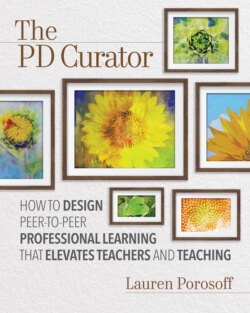Читать книгу The PD Curator - Lauren Porosoff - Страница 15
Orienting Teachers to Learning
ОглавлениеAlthough museum visitors might quickly infer the rules of engagement—as Allison did at a very young age—they still need time to figure out which exhibits they want to visit, how long they'll stay in each one, how to get around the museum, and so on.
Professors John Falk and Lynn Dierking (2018) explain that first-time museum visitors behave differently than people who visit frequently: "Much of the first-time museum visitor's attention is absorbed in orientation, way-finding, behavior modeling, and general efforts to cope with novelty. The frequent museum visitor, by comparison, knows where they are going and how to behave; they are able to focus more on exhibitions than are first-time visitors" (p. 52).
Maybe you've witnessed similar "efforts to cope with novelty" when educators not used to learning together attempt to do so. Topial had four divisions—two lower schools, a middle school, and an upper school—but we hardly ever all met together. Even when meetings were on my division's campus, I wasn't used to being there for that purpose and with that group of people, so there was a sort of disorientation I had to get over. I wasn't sure where to sit because my familiar colleagues were spread throughout the room, interspersed with people I recognized but didn't know, with people I didn't even recognize, and with people I'd talked to in the past but whose names I'd forgotten. As a result, at least some of the mental energy I could have devoted to learning was spent searching for people I knew, observing how those I didn't know were reacting to the presentations, and looking for potential allies in my learning and work.
We know that people need time to figure out their surroundings and find their way. That's why many schools have an orientation for first-year students. Kindergartners might have a week of half-days so they can get used to their classroom and its routines—and so they can start getting acquainted with their teacher and classmates. Incoming high school students also have an orientation day so they can find their way around the building and meet their teachers before starting any academic work.
But even though we use the word orientation to refer to such events, it's more of a psychological process. We orient ourselves to our physical, temporal, and social contexts. That is, we get used to the building, schedule, and groups in which we find ourselves. It's not that we can't do any learning or work before we've gotten used to those surroundings; even first-time museum visitors look at, appreciate, and remember the art—but it's a different overall experience. If we want teachers to engage fully in peer-to-peer PD and get more out of it, then we might consider how we structure their day-to-day physical, temporal, and social contexts to orient them toward learning from and with one another.
